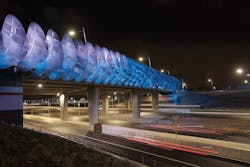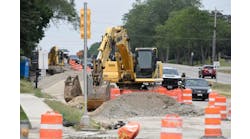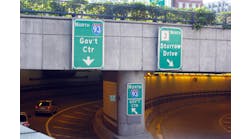The recently opened Gateway WA freight access project at Perth Airport in Australia has already proven successful in fulfilling its function.
Completed almost a year ahead of schedule and under budget, the new roadway provides a safer and more efficient transport network around Perth Airport.
The area around the airport serves as a major passenger and freight network hub for the metropolitan district. Strong growth in passenger traffic at the airport has added significant roadway congestion to the region. Further traffic growth is expected to be created by industrial development in the nearby areas of Kewdale and Forrestfield.
Estimates are that passenger air travel and road freight activity will double by 2031. Infrastructure Australia identified the Gateway WA project as nationally significant under its Competitive International Gateways goal to improve Australia’s trade performance, a major impetus for the project.
Tonkin Highway Dunreath Drive interchange.
Zoned in
The $1 billion roadway is the largest infrastructure project ever undertaken by Main Roads Western Australia. Located mainly within the local government area of the city of Belmont, with the eastern area in the Shire of Kalamunda, it also is one of the largest and most complex transport projects ever undertaken in Western Australia. Ultimately, the project will accommodate a population of 3.5 million and an airport capable of conveying 40 million passenger movements per year.
The project includes road and bridge improvements, local road modifications, facilities and connections for pedestrians and cyclists, noise walls, landscaping, and the use of intelligent transportation systems (ITS) technology. The Gateway WA project consists of three separate zones:
- The northern zone entails an upgrade to a six-lane standard of Tonkin Highway from Great Eastern Highway to Leach Highway. A dumbbell interchange was constructed at Dunreath Drive. A free-flowing interchange was constructed to connect Leach and Tonkin Highways with a new airport access road. The airport access road in the vicinity of this interchange was constructed as part of Gateway WA, while the majority of the road was built as part of the separate airport redevelopment project;
- The western zone covers upgrades in Kewdale, including an interchange at Leach Highway and Abernethy Road and upgrading the former to expressway standards. In support of this, various improvements were made to the local road network, including installing traffic signals at some intersections and restricting access to others; and
- The southern zone consists of the upgrade to a six-lane standard of Tonkin Highway from Leach to Roe Highway. A single-point urban interchange was constructed to connect Tonkin Highway, Kewdale Road and Horrie Miller Drive. The existing diamond interchange at Tonkin and Roe highways was upgraded with additional ramps, and an entrance ramp was constructed from Abernethy Road to Tonkin Highway southbound.
Abernethy Road bridge over Leach Highway.
Innovation surge
The bridges on the Gateway WA project incorporate many innovations that enhance the urban design features and reduce the impact of piers and deck thickness. Bridge decks incorporate precast beams and girders made fully continuous in order to reduce the depth of the deck structure. In-situ diaphragms are concealed within the deck structure to span between piers and reduce the number of pier structures required. Bridge parapet profiles and termination details were carefully chosen to provide a unique and distinctive theme to the project. Extensive use of precast elements speeded up construction and limited the use of falsework, reducing the impact of work on the traveling public.
The close proximity to the airport combined with the occurrence of groundwater at shallow depths imposed significant design and construction challenges. An entire section of the road alignment at the Leach and Tonkin Highway intersection dips below groundwater level to avoid interference with airport navigation systems. Submerged concrete pavement structures, known as bath structures, were designed to sustain buoyancy forces induced by groundwater while maintaining full waterproofing. As part of this solution, an innovative buoyancy control system using screw piles was developed and implemented.
When detailed design commenced, the intersection of Leach Highway and Abernethy Road featured a compact diamond interchange. The design team, including AECOM, put forward an alternative solution carrying Abernethy Road over Leach Highway and providing a single-point urban interchange (SPUI), the first in Western Australia. The revised scheme has reduced interchange traffic-signal times, improved traffic flow and congestion, and minimized overlooking to adjacent private property. The innovative solution also provided larger turning radii at the SPUI, resulting in improved freight efficiency for road train and B-Double vehicles.
The Leach Highway Abernethy Road Interchange SPUI was constructed in a top-down manner by using continuous flight auger (CFA) piles. This allowed reduced bridge spans, much improved traffic around the intersection and minimum disruption during construction. An underpass at Roe Highway was built within three days using a sophisticated temporary works design and a flawlessly executed construction sequence. These are both examples of the commitment of the Alliance team to provide innovative design and construction solutions with a reduced impact to users, residents and businesses.
The iconic nature of the Gateway WA project demanded a visionary approach in order to create a lasting impression for road users, residents and visitors to Western Australia. Urban design played a crucial role in integrating function, form and aesthetic outcomes for infrastructure elements, including bridges, retaining systems, noise walls, barriers, fencing, lighting, gantries, paths and drainage. Built and natural forms were integrated with public art opportunities to provide a memorable “gateway” experience to Perth.
The project applies innovative urban design concepts to create a themed journey that includes colored and textured way-finding cues to Perth landmarks of the “city, river and range.” The urban design aims to aid road journey navigation and make a positive and lasting impression for visitors. The urban design draws upon the natural qualities of WA’s landscape and represents the earth, sky and wildflower vegetation.
A bird’s-eye view of the completed Leach Highway Abernethy Road Interchange.
A key urban design and technical challenge was how to achieve an “iconic” stature for the main airport intersection despite being severely restricted in the height of design by air traffic regulations. The solution adopted was to focus on the sinuous and curvilinear form of the highway elements to knit these together with the landscape ground plane into a composition of colorful “ribbon-like” elements.
A project of this nature had never been carried out in Western Australia previously and required designers from various disciplines with the relevant experience and capability. Teaming involved a core design team of AECOM, GHD and BG&E, plus Tonkin Zulaikha Greer Architects and DJ Coalition lighting specialists. The urban design team collaborated across Perth, Brisbane, Sydney and Auckland.
Successfully developing and realizing urban design outcomes required ownership by all members of the Alliance Team. The urban design team was primarily responsible for developing the concept and carrying out design intent. However, significant daily collaboration also was required with engineering disciplines; artists; commercial, community and stakeholder engagement; cost estimators; safety and construction specialists; and fabricators.
The integrated Alliance team—consisting of Main Roads Western Australia, AECOM, CPB Contractors (formerly known as Leighton Contractors), Georgiou, and other industry design leaders (GHD and BG&E)—staged the work on site in order to minimize disruption to local businesses, residents, road users and the freight industry. Wherever possible, priority was given to preserving travel times, maintaining access to driveways and public transport, and ensuring the safe passage of pedestrians and cyclists.
AECOM worked with the Alliance Partners using an inclusive approach, exploring the sustainability impact from inception to completion and beyond, implementing leading sustainability initiatives across the entire project delivery phase. These methods include specifying energy-efficient light-emitting diode technology in the highway lighting system, purchasing electric vehicles for use during community engagement activities and using more than 1 million tons of recycled material as well as repurposing 1.8 million tons from cut-waste recycled materials.
The sustainability program has resulted in the project becoming the first road project in Australia to earn an Infrastructure Sustainability Council of Australia Excellent As-Built rating.
Jointly funded by the Australian and state governments, the Gateway WA project has formed an iconic gateway to Western Australia that will be the first impression of visitors to the state for many years. Completed early in 2016, the project delivered an efficient road and bridge network to the new Perth Airport precinct as well as the surrounding businesses and residential areas, servicing the area’s rapidly growing transport and logistic operations.



